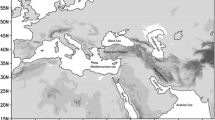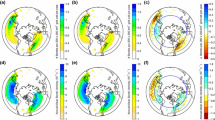Abstract
The dynamic and kinematic characteristics of surface explosive cyclones in the Mediterranean are examined and compared to those of ordinary cyclones. The cyclone detection is performed with the tracking algorithm developed in the University of Melbourne, using the 1° × 1° ERA-40 mean sea level pressure dataset for a 40 year period. It is verified that the explosive cyclogenesis in the Mediterranean is mainly a maritime phenomenon, occurring along the northern Mediterranean coast during the cold season. On the contrary, the ordinary cyclogenesis exhibits significant maxima in both continental and maritime environments throughout the year. The explosive cyclones are characterized by longer lifetime and greater propagation speed. They are larger and deeper in the eastern Mediterranean, whereas the ordinary cyclones are deeper in the western and larger in the eastern Mediterranean. The trend analysis revealed that both explosive and ordinary cyclones become less frequent in the Mediterranean basin, while there is a tendency for deeper ordinary cyclones over North Africa and shallower over the Aegean Sea and Cyprus.












Similar content being viewed by others
References
Allen JT, Pezza AB, Black MT (2010) Explosive cyclogenesis: a global climatology comparing multiple reanalyses. J Clim 23:6468–6484. doi:10.1175/2010JCLI3437.1
Alpert P, Neeman BU, Shay-El Y (1990) Intermonthly variability of cyclone tracks in the Mediterranean. J Clim 3:1474–1478. doi:10.1175/1520-0442(1990)003<1474:IVOCTI>2.0.CO;2
Alpert P, Stein U, Tsidulko M (1995) Role of sea fluxes and topography in eastern mediterranean cyclogenesis. Global Atmos Ocean Syst 3:55–79
Bartholy J, Pongrácz R, Pattantyús-Ábrahám M (2009) Analyzing the genesis, intensity, and tracks of western Mediterranean cyclones. Theor Appl Climatol 96:133–144. doi:10.1007/s00704-008-0082-9
Bergeron T (1954) The problem of tropical hurricanes. Q J R Meteorol Soc 80:131–164
Bosart LF (1981) The President’s Day Snowstorm of 18–19 February 1979. A subsynoptic event. Mon Weather Rev 109:1542–1566
Böttger H, Eckardt M, Katergiannakis U (1975) Forecasting extratropical storms with hurricane intensity using satellite information. J Appl Meteorol 14:1259–1265
Campins J, Genovés A, Picornell MA, Jansà A (2010) Climatology of Mediterranean cyclones using the ERA-40 dataset. Int J Climatol 31:1596–1614. doi:10.1002/joc.2183
Capaldo M, Conte M, Finizio C, Todisco G (1980) A detailed analysis of a severe storm in the central Mediterranean: the case of Trapani flood. Riv Meteorol Aeronaut XL 213:183–199
Conte M (1986) The meteorological “bomb” in the Mediterranean: a synoptic climatology. Riv Meteorol Aeronaut 46:121–130
Conte M, Piervitali E, Colacino M (1997) The meteorological bomb in the Mediterranean. INM/WMO International symposium on cyclones and hazardous weather in the Mediterranean, MMA/UIB, pp 283–287
Courtier P et al (1998) The ECMWF implementation of three dimensional variational assimilation 3D-Var. Part I: formulation. Q J R Meteorol Soc 124:1783–1808. doi:10.1002/qj.49712455002
Fink AH, Pohle S, Pinto JG, Knippertz P (2012) Diagnosing the influence of diabatic processes on the explosive deepening of extratropical cyclones. Geophys Res Lett 39 L07803. doi: 10.1029/2012GL051025
Fita L, Romero R, Luque A, Emanuel K, Ramis C (2007) Analysis of the environments of seven Mediterranean tropical-like storms using an axisymmetric, nonhydrostatic, cloud resolving model. Nat Hazards Earth Syst Sci 7:41–56
Flocas A (1988) Frontal depressions over the Mediterranean Sea and central Southern Europe. Mediterr 4:43–52
Flocas HA, Simmonds I, Kouroutzoglou J, Kevin K, Hatzaki M, Bricolas V, Asimakopoulos D (2010) On cyclonic tracks over the eastern Mediterranean. J Clim 23:5243–5257. doi:10.1175/2010Jcli3426.1
Flocas HA, Kountouris P, Kouroutzoglou J, Hatzaki M, Keay K, Simmonds I (2012) Vertical characteristics of cyclonic tracks over the eastern Mediterranean during the cold period of the year. Theor Appl Climatol (online). doi:10.1007/s00704-012-0737-4
Gil VE, Genovés A, Picornell MA, Jansà A (2003) Automated database of cyclones from the ECMWF model: preliminary comparison between west and east Mediterranean basins, Proc 4th EGS plinius conference. Mallorca, Spain
Gyakum JR (1983a) On the evolution of the QE II storm. I: synoptic aspects. Mon Weather Rev 111:1137–1155
Gyakum JR (1983b) On the evolution of the QE II storm. II: dynamic and thermodynamic structure. Mon Weather Rev 111:1156–1173
Gyakum JR, Danielson RE (2000) Analysis of meteorological precursors to ordinary and explosive cyclogenesis in the western north Pacific. Mon Weather Rev 128:851–863. doi:10.1175/1520-0493(2000)128<0851:AOMPTO>2.0.CO;2
Hedley M, Yau MK (1991) Anelastic modeling of explosive cyclogenesis. J Atmos Sci 48:711–727
H.M.S.O. (1962) Weather in the Mediterranean, Vol. 1, 2nd ed. Meteorological Office:London; 362
Homar V, Jansà A, Campins J, Genovés A, Ramis C (2007) Towards a systematic climatology of sensitivities of Mediterranean high impact weather: a contribution based on intense cyclones. Nat Hazard Earth Syst Sci 7:445–454. doi:10.5194/nhess-7-445-2007
Jansà A, Alpert P, Buzzi A, Arbogast P (2001) MEDEX, cyclones that produce high impact weather in the Mediterranean, available at http://medex.inm.uib.es
Karacostas TS, Flocas AA (1983) The development of the “bomb” over the Mediterranean area. La Meteorologie, Actes de la conference “eau verte” 34:351–358
Keable M, Simmonds I, Keay K (2002) Distribution and temporal variability of 500 hPa cyclone characteristics in the Southern Hemisphere. Int J Climatol 22:131–150. doi:10.1002/joc.728
Kouroutzoglou J, Flocas HA, Simmonds I, Keay K, Hatzaki M (2011a) Climatological aspects of explosive cyclones in the Mediterranean. Int J Climatol 31:1785–1802. doi:10.1002/joc.2203
Kouroutzoglou J, Flocas HA, Simmonds I, Keay K, Hatzaki M (2011b) Assessing characteristics of Mediterranean explosive cyclones for different data resolution. Theor Appl Climatol 105:263–275. doi:10.1007/s00704-010-0390-8
Kuo YH, Reed RJ, Low-Nam S (1991) Effects of surface energy fluxes during the early development and rapid intensification stages of seven explosive cyclones in the western Atlantic. Mon Weather Rev 119:457–476. doi:10.1175/1520-0493(1991)119<0457:EOSEFD>2.0.CO;2
Lagouvardos K, Kotroni V, Defer E (2007) The 21–22 January 2004 explosive cyclogenesis over the Aegean Sea: observations and model analysis. Q J R Meteorol Soc 133:1519–1531. doi:10.1002/qj.121
Leonard SR, Turner J, van Der Wal A (1999) An assessment of three automatic depression tracking schemes. Meteorol Appl 6:173–183. doi:10.1017/S135048279900119X
Lim EP, Simmonds I (2002) Explosive cyclone development in the Southern Hemisphere and a comparison with Northern Hemisphere events. Mon Weather Rev 130:2188–2209. doi:10.1175/1520-0493
Lim EP, Simmonds I (2007) Southern Hemisphere winter extratropical cyclone characteristics and vertical organization observed with the ERA-40 data in 1979–2001. J Clim 20:2675–2690. doi:10.1175/JCLI4135.1
Lionello P, Bhend J, Buzzi A, Della-Marta PM, Krichak SO, Jansà A, Maheras P, Sanna A, Trigo IF, Trigo R (2006) Cyclones in the Mediterranean region: climatology and effects on the environment. In: Lionello P, Malanotte-Rizzoli P, Boscolo R (eds) Mediterranean climate variability. Elsevier, Amsterdam
Lolis CJ, Bartzokas A, Katsoulis BD (2004) Relation between sensible and latent heat fluxes in the Mediterranean and precipitation in the Greek area during winter. Int J Climatol 24:1803–1816. doi:10.1002/joc.1112
Maheras P, Flocas HA, Patrikas I, Anagnostopoulou C (2001) A 40 year objective climatology of surface cyclones in the Mediterranean region: spatial and temporal distribution. Int J Climatol 21:109–130. doi:10.1002/joc.599
Murray RJ, Simmonds I (1991a) A numerical scheme for tracking cyclone centres from digital data. Part I: development and operation of the scheme. Aust Meteorol Mag 39:155–166
Murray RJ, Simmonds I (1991b) A numerical scheme for tracking cyclone centres from digital data. part II: application to January and July general circulation model simulations. Aust Meteorol Mag 39:167–180
Neu et al. (2012) IMILAST: a community effort to intercompare extratropical cyclone detection and tracking algorithms: assessing method-related uncertainties. Bull Am Meteorol Soc (e-View) doi:10.1175/BAMS-D-11-00154.1
Nissen KM, Leckebusch GC, Pinto JG, Renggli D, Ulbrich S, Ulbrich U (2010) Cyclones causing wind storms in the Mediterranean: characteristics, trends and links to large-scale patterns. Nat Hazard Earth Syst Sci 10:1379–1391. doi:10.5194/nhess-10-1379-2010
Palmén E, Netwon CW (1969) Atmospheric circulation systems: their structure and physical interpretation. Academic Press, New York
Petterssen S (1956) Weather analysis and forecasting. Volume I: Motion and motion systems. McGraw Hill, New York
Picornell MA, Jansà A, Genovés A, Campins J (2001) Automated database of mesocyclones from the HIRLAM(INM)-0.5° analyses in the western Mediterranean. Int J Climatol 21:335–354. doi:10.1002/joc.621
Piervitali E, Colacino M, Conte M (1997) Signals of climatic change in the central-western Mediterranean basin. Theor Appl Climatol 58:211–219. doi:10.1007/BF00865021
Pinto JG, Spangehl T, Ulbrich U, Speth P (2005) Sensitivities of a cyclone detection and tracking algorithm: individual tracks and climatology. Meteorol Z 14:823–838. doi:10.1127/0941-2948/2005/0068
Prezerakos NG, Michaelides SC (1989) A composite diagnosis in sigma coordinates of the atmospheric energy balance during intense cyclonic activity. Q J R Meteorol Soc 115:463–486. doi:10.1002/qj.49711548703
Radinovic D (1965) Cyclonic activity in yugoslavia and surrounding areas. Meteorol Atmos Phys 14:391–408
Radinovic D (1987) Mediterranean cyclones and their influence on the weather and climate. WMO, PSMP Report Series, 24, pp. 131
Raible CC, Della-Marta PM, Schwierz C, Wernli H, Blender R (2008) Northern Hemisphere extratropical cyclones: a comparison of detection and tracking methods and different reanalyses. Mon Weather Rev 136:880–897. doi:10.1175/2007MWR2143.1
Roebber PJ (1984) Statistical analysis and updated climatology of explosive cyclones. Mon Weather Rev 112:1577–1589
Roebber PJ (1989) On the statistical analysis of cyclone deepening rates. Mon Weather Rev 117:2293–2298
Rudeva IA, Gulev SK (2007) Climatology of cyclone size characteristics and their changes during the cyclone life cycle. Mon Weather Rev 135:2568–2587. doi:10.1175/MWR3420.1
Sanders F (1986) Explosive cyclogenesis in the west-central North Atlantic Ocean, 1981–84. part I: composite structure and mean behavior. Mon Weather Rev 114:1781–1794
Sanders F, Gyakum JR (1980) Synoptic-dynamic climatology of the “Bomb”. Mon Weather Rev 108:1589–1606. doi:10.1175/1520-0493
Shay-El Y, Alpert P (1991) A diagnostic study of winter diabatic heating in the Mediterranean in relation to cyclones. Q J R Meteorol Soc 117:715–747. doi:10.1002/qj.49711750004
Simmonds I (2000) Size changes over the life of sea level cyclones in the NCEP reanalysis. Mon Weather Rev 128:4118–4125. doi:10.1175/1520-0493(2000)129<4118:SCOTLO>2.0.CO;2
Simmonds I, Keay K (2000) Mean Southern Hemisphere extratropical cyclone behavior in the 40-year NCEP-NCAR reanalysis. J Clim 13:873–885. doi:10.1175/1520-0442(2000)013<0873:MSHECB>2.0.CO;2
Simmonds I, Murray RJ (1999) Southern extratropical cyclone behavior in ECMWF analyses during the FROST special observing periods. Weather Forecast 14:878–891. doi:10.1175/1520-0434
Simmonds I, Murray RJ, Leighton RM (1999) A refinement of cyclone tracking methods with data from FROST. Aust Meteorol Mag, Special Edition, pp 35–49
Solomon S, Qin D, Manning M et al (2007) Climate change 2007: contribution of working group I to the fourth assessment report of the intergovernmental panel on climate change. Cambridge University Press, Cambridge
Trigo IF (2006) Climatology and interannual variability of storm-tracks in the Euro-Atlantic sector: a comparison between ERA-40 and NCEP/NCAR reanalyses. Clim Dyn 26:127–143. doi:10.1007/s00382-005-0065-9
Trigo IF, Davies TD, Bigg GR (1999) Objective climatology of cyclones in the Mediterranean region. J Clim 12:1685–1696. doi:10.1175/1520-0442(1999)012<1685:OCOCIT>2.0.CO;2
Trigo IF, Bigg GR, Davies TD (2002) Climatology of cyclogenesis mechanisms in the Mediterranean. Mon Weather Rev 130:549–569. doi:10.1175/1520-0493(2002)130<0549:COCMIT>2.0.CO;2
Uppala SM et al (2005) The ERA-40 Re-analysis. Q J R Meteorol Soc 131:2961–3012. doi:10.1256/qj.04.176
Yau MK, Jean M (1989) Synoptic aspects and physical processes in the rapidly intensifying cyclone of 6–8 March 1986. Atmos-Ocean 27:59–86. doi:10.1080/07055900.1989.9649328
Zolina O, Gulev SK (2002) Improving the accuracy of mapping cyclone numbers and frequencies. Mon Weather Rev 130:748–759. doi:10.1175/1520-0493(2002)130<0748:ITAOMC>2.0.CO;2
Author information
Authors and Affiliations
Corresponding author
Rights and permissions
About this article
Cite this article
Kouroutzoglou, J., Flocas, H.A., Hatzaki, M. et al. A high-resolution climatological study on the comparison between surface explosive and ordinary cyclones in the Mediterranean. Reg Environ Change 14, 1833–1846 (2014). https://doi.org/10.1007/s10113-013-0461-3
Received:
Accepted:
Published:
Issue Date:
DOI: https://doi.org/10.1007/s10113-013-0461-3




